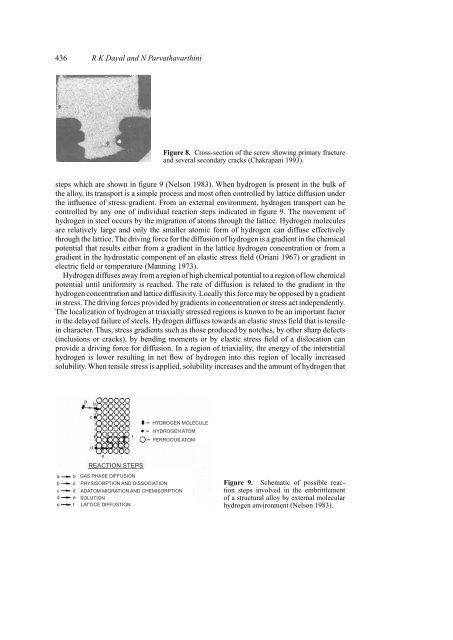Hydrogen embrittlement in power plant steels - Indian Academy of ...
Hydrogen embrittlement in power plant steels - Indian Academy of ...
Hydrogen embrittlement in power plant steels - Indian Academy of ...
You also want an ePaper? Increase the reach of your titles
YUMPU automatically turns print PDFs into web optimized ePapers that Google loves.
436 R K Dayal and N Parvathavarth<strong>in</strong>i<br />
Figure 8. Cross-section <strong>of</strong> the screw show<strong>in</strong>g primary fracture<br />
and several secondary cracks (Chakrapani 1993).<br />
steps which are shown <strong>in</strong> figure 9 (Nelson 1983). When hydrogen is present <strong>in</strong> the bulk <strong>of</strong><br />
the alloy, its transport is a simple process and most <strong>of</strong>ten controlled by lattice diffusion under<br />
the <strong>in</strong>fluence <strong>of</strong> stress gradient. From an external environment, hydrogen transport can be<br />
controlled by any one <strong>of</strong> <strong>in</strong>dividual reaction steps <strong>in</strong>dicated <strong>in</strong> figure 9. The movement <strong>of</strong><br />
hydrogen <strong>in</strong> steel occurs by the migration <strong>of</strong> atoms through the lattice. <strong>Hydrogen</strong> molecules<br />
are relatively large and only the smaller atomic form <strong>of</strong> hydrogen can diffuse effectively<br />
through the lattice. The driv<strong>in</strong>g force for the diffusion <strong>of</strong> hydrogen is a gradient <strong>in</strong> the chemical<br />
potential that results either from a gradient <strong>in</strong> the lattice hydrogen concentration or from a<br />
gradient <strong>in</strong> the hydrostatic component <strong>of</strong> an elastic stress field (Oriani 1967) or gradient <strong>in</strong><br />
electric field or temperature (Mann<strong>in</strong>g 1973).<br />
<strong>Hydrogen</strong> diffuses away from a region <strong>of</strong> high chemical potential to a region <strong>of</strong> low chemical<br />
potential until uniformity is reached. The rate <strong>of</strong> diffusion is related to the gradient <strong>in</strong> the<br />
hydrogen concentration and lattice diffusivity. Locally this force may be opposed by a gradient<br />
<strong>in</strong> stress. The driv<strong>in</strong>g forces provided by gradients <strong>in</strong> concentration or stress act <strong>in</strong>dependently.<br />
The localization <strong>of</strong> hydrogen at triaxially stressed regions is known to be an important factor<br />
<strong>in</strong> the delayed failure <strong>of</strong> <strong>steels</strong>. <strong>Hydrogen</strong> diffuses towards an elastic stress field that is tensile<br />
<strong>in</strong> character. Thus, stress gradients such as those produced by notches, by other sharp defects<br />
(<strong>in</strong>clusions or cracks), by bend<strong>in</strong>g moments or by elastic stress field <strong>of</strong> a dislocation can<br />
provide a driv<strong>in</strong>g force for diffusion. In a region <strong>of</strong> triaxiality, the energy <strong>of</strong> the <strong>in</strong>terstitial<br />
hydrogen is lower result<strong>in</strong>g <strong>in</strong> net flow <strong>of</strong> hydrogen <strong>in</strong>to this region <strong>of</strong> locally <strong>in</strong>creased<br />
solubility. When tensile stress is applied, solubility <strong>in</strong>creases and the amount <strong>of</strong> hydrogen that<br />
a<br />
b<br />
c<br />
HYDROGEN MOLECULE<br />
HYDROGEN ATOM<br />
f<br />
FERROOUS ATOM<br />
d<br />
e<br />
REACTION STEPS<br />
a<br />
b<br />
c<br />
d<br />
e<br />
b<br />
c<br />
d<br />
e<br />
f<br />
GAS PHASE DIFFUSION<br />
PHYSISORPTION AND DISSOCIATION<br />
ADATOM MIGRATION AND CHEMISORPTION<br />
SOLUTION<br />
LATTICE DIFFUSTION<br />
Figure 9. Schematic <strong>of</strong> possible reaction<br />
steps <strong>in</strong>volved <strong>in</strong> the <strong>embrittlement</strong><br />
<strong>of</strong> a structural alloy by external molecular<br />
hydrogen environment (Nelson 1983).
















